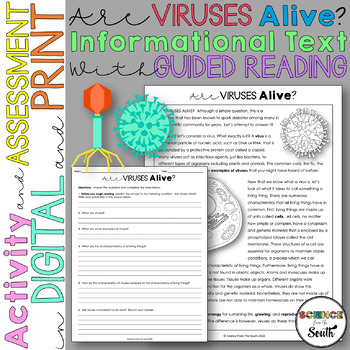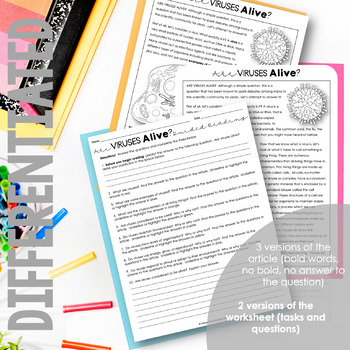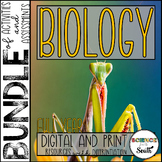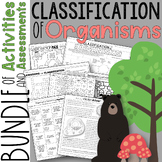Are Viruses Alive? Guided Reading Article with Notes and Assessment Activity
- PDF
- Google Apps™
- Easel Activity
- Easel Assessment

What educators are saying
Also included in
- Your students can use any biology curriculum bundle to learn about biology concepts, including characteristics of life, biochemistry, classification, cells, genetics, evolution, and ecology with any biology bundle. But, what if you had a full year of biology creative curriculum activities, assessmenPrice $230.00Original Price $401.25Save $171.25
- Your students can learn about classification of living things! But, can each of your individual students learn with differentiated classification of organisms activities and assessments that best fit their learning needs? They can with this Classification of Organisms Activity and Assessment Unit BuPrice $17.00Original Price $24.50Save $7.50
Description
You could simply tell your students that viruses are not classified as living things or point them to a website that shares the information. But, why when you can use this activity to help them learn it through engagement, exploration, and explanation of the classification of viruses? This activity is perfect for teaching students that viruses are not classified as living things and why we don't. The activity includes three differentiated versions of a non-fictional article about viruses, what they are, and the characteristics of living things. Students use one of two differentiated versions of a guided reading worksheet to learn about the topic as they read the informational text. So, do you need a digital or print activity that will engage your students in exploring about the classification of viruses?
This guided reading activity is just what you need to engage your middle and high school students in Biology or Life Science in an in-class or homework exploration activity. Earn favor with your administrators and meet individual student needs with the various levels of differentiation in the article and the guided reading worksheet that you can use for gifted, honors, and students with disabilities. Furthermore, save yourself time with the no prep activity in print and digital.
But, don't just take my word for it. Check out what other teachers say about the Are Viruses Living? Guided Reading Activity
⭐️⭐️⭐️⭐️⭐️ "Great activity. After teaching the needs of microorganisms I used this article as my lead into the virus topic. Love the tie in to Characteristics of life. This was easy to use and virtual friendly." -Annisa
⭐️⭐️⭐️⭐️⭐️ "This was a great additional activity to use during my Characteristics of Life Unit. The students loved learning more about Viruses." -Erin
⭐️⭐️⭐️⭐️⭐️ "Easy work for substitute teachers. My students could answer all the questions without any guidance." -Brenna
You Will Get:
- A low prep, print-and-go resource that saves you, the teacher, valuable time and energy and engages your students into exploring the classification of viruses.
- A resource with a table of contents for easy organizing and printing.
- Three differentiated versions of the non-fiction article (bold terms, no bold terms, no question answer).
- Two differentiated versions of the guided reading worksheet (with tasks for identifying key information in the article, with questions)
- A True/False assessment to use formatively as homework or a ticket-out-the-door
- An Easel assement
- A How to Guide with ideas on engaging your students in the activity, use of the activity, further differentiation, and ways to incorporate technology.
- Digital options of the resource in Google Slides and TpT Easel.
- Answer keys.
You Will Like:
Are Viruses Alive? Cloze Reading Worksheet
Classification of Organisms Concept Map Graphic Organizer
Classification of Living Things Bundle of Activities and Assessments
BIG Biology Bundle of Activities and Assessments
Feedback and Followers:
Did you know that you can receive credit towards future TpT purchases by reviewing this product? Leave a review at the product page after you download the resource or through “My Purchases”. Use your TpT credits that you earn to purchase other resources.
Do you want to be the first to know about new resources, sales, and free resources? Sign-up here to get email notifications and my Mix it Up Activities and Assessment eBook with templates. And don't forget to click the green star next to my store logo to become a follower. Connect in other ways using the links below! We love to see resources in action. Share them at @sciencefromthesouth to receive a FREEBIE!
Happy Teaching!
Heather








